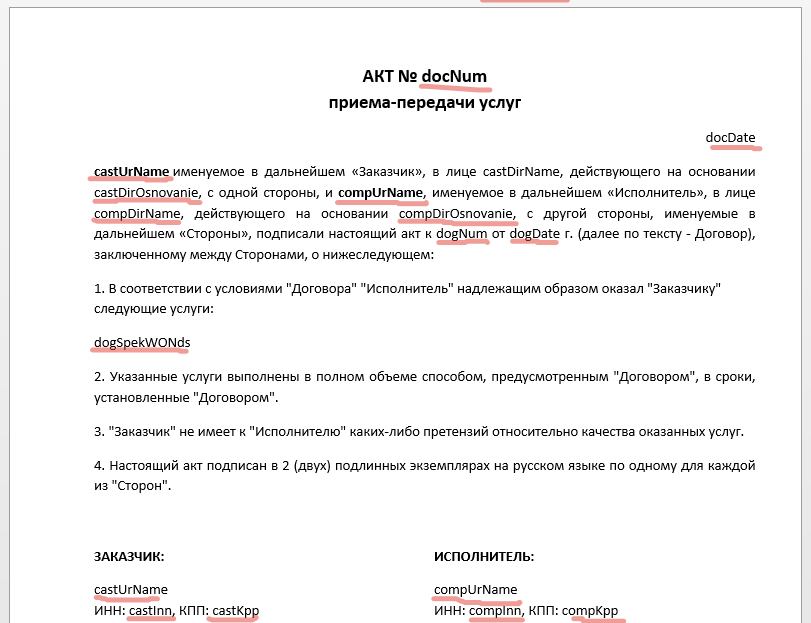Reduce time spent on creating documents
Part 1. Do you see a gopher? And I do not see, but he is.
In other words, if the problem is not visible, it does not mean that it does not exist. We will understand?
The work of the sales department is associated with the creation of a huge number of documents of various types - from banal commercial offers (KP) to legal contracts. If you have ever been engaged in active sales, then you know that in order to increase the efficiency of a KP, it must be made personalized — that is, at least specify the name of the contact person. As for the contracts, they need to fill in much more information - all details of the counterparty, attach a specification, specify the amount, etc. It seems nothing complicated and what can be improved here?

Business Cases from Yoolla
')
Indeed, everything is simple - open the blank and enter your data using the “Copy-Inserted” method, even a low-skilled employee will cope with this. Simple, but not so.
This incident occurred while I was working at one federal-level IT company - we participated in the so-called “School Project”, in which several vendors provided software for schools at ridiculous prices. The problem was that there were a lot of schools in the Perm region, and the contracts were concluded with each of them personally. For this work had to allocate an individual employee. So, this employee spent almost two weeks creating contracts (+ appendices to them with a list of supplied products) for this project - manually drove the details into the template.
Everything seems to be not bad, but here some of the schools (it apparently still came to them that the price tag was just free) decided to change the composition of the products - which means you need to recalculate the amount of contracts and redo the specifications. It was a “loss-of-loss” - a lot of time was spent (time = money) and it was necessary to redo some of the work already done.
As a rule, in order to increase efficiency, it does not occur to anyone to automate any routine operations, especially work with documents. But let's see what problems we saw in this matter:
A large number of documents requires an enormous amount of time, besides, the “human factor” cannot be excluded. For example, to make 100 documents of the same type will take about 500 minutes (5 minutes per document) or 8 hours of working time - these are enormous costs, and we still do not take into account the time required for checking and correcting errors
A large number of documents of different content - in some cases it is required for different clients to compile documents of different content, which not only complicates the task, but also requires more time to complete it,
Changes in the document - in order to correct the document in case of an error, you will have to do almost the same work as when creating a new document - this is a waste of time.
The situation, of course, is exaggerated, but if you consider how much KP, Contracts and other documents your employees make up, the figure will most likely turn out to be much more.
In this case, there is another factor - it is required that the “procurement” that employees use is correct and relevant. After all, if an employee “has done” hundreds of documents and all of them contain any error or inaccuracy, then the work is not only done in vain, but it may cause any damage in the future.
Let us give one example that any experienced specialist encountered. You will surely recall it from your experience:
Negotiations with the client ended successfully. The client sends his details and we happily make a contract for him, attachments to the contract and invoice. And here it “turns out” that the contracts in our direction are conducted through the client’s subsidiary company and we urgently need to redo the entire package of documents into new details. It’s unpleasant of course, but what to do is reworking the entire package. New details and extra time.
When it comes to a single case, there is nothing criminal and not feasible here - well, we will spend another half hour to rework the documents. But just as a mosaic is made up of individual elements, so the time spent in vain is added up to hours and even days of working time, which costs money that we pay to performers. And that means again “the cosmos is heated”.
Part 2. Choose an implementation option.
After careful analysis and customer surveys, we came to the conclusion that the main part of the documents is created using any template. This requires a database in which information for creating documents and the template itself will be stored. We have data with information, since Yoolla CRM - this is the repository of all the necessary information, it remains only to implement the creation of a document on the template.
We chose the option - use templates in Word 2007 format (i.e. * .docx) - as the most convenient and outstanding result. The advantage of a template prepared in Word is the simplicity of its creation - because the majority of users (and maybe 100%) of our system are literate people and have the skills to work with MS Office.
The result was a module capable of issuing any already filled out document on a pre-prepared template. In this case, the creation of a document takes just a few seconds.
Part 3. Example of creating a template
To prepare the template, we will need MS Word or WPS Office (or any other program that can save the document in * .docx format). For a basis, you can take a document that you already use - existing controls, contracts, additional agreements, acts, receipts, etc.
Step 1. Open our blank and put the right tags in the right places of the template using the tag system. We, for example, used the Transfer and Acceptance Act and we got this pattern:
Document Generator in Yoolla CRM

Step 2. Load the template in Yoolla CRM and save
As you can see, everything is quite simple and anyone who is familiar with MS Word can cope with the creation of a template. Now everything depends on your imagination and patience, because It is possible to create a completely wide range of different documents - not only for external, but also for internal use.
Tags cover the data on Clients - from the contents of the client card to its details, Contacts - all available information, including additional fields and Transactions - from the date of the transaction to the specification with and without VAT.
Part 4. We consider value, i.e. money
So, now you can roughly estimate how much time a year you and your employees spend on “space heating”, because now you can:
- reduce costs by reducing the time to create new documents 3 times
- reduce costs by reducing the time to re-create documents (due to errors or other changes) 3 times
- reduce the cost of assistant managers responsible for working with documents (you know what to do with them) - by 2-3 times
- reduce costs caused by errors when creating documents - not measurable
If we suddenly, accidentally, in an incomprehensible way, did not convince you that only by using the Document Generator module you start saving (Saved - it means earned), then we can offer only one thing - count your expenses, but we'll see.
More information about the module can be found in the documentation .
Source: https://habr.com/ru/post/294232/
All Articles